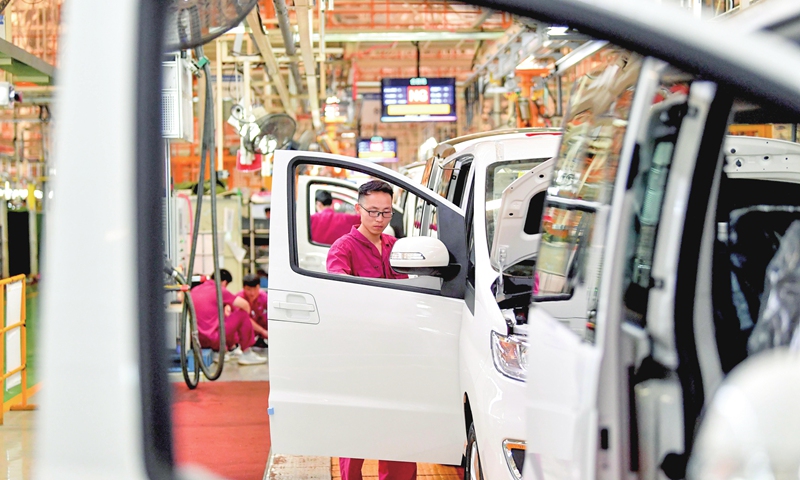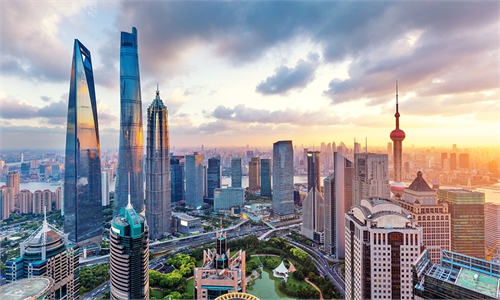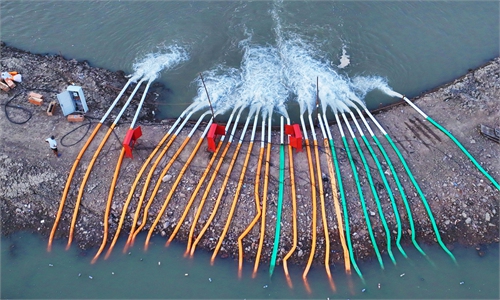China's State Council assigns task forces to major economic provinces to oversee local pro-stabilization policy implementation

Employees assemble cars at a vehicle manufacturer in Bozhou, East China's Anhui Province on July 12, 2022. Assembly lines at the manufacturer are busy stamping, welding, painting and putting together new cars despite hot weather. Photo: cnsphoto
The State Council, China's cabinet, has assigned task forces to some major economic provinces to oversee local implementation of wide-ranging policies to stabilize the economy, as the country is tuning up regional economic powerhouses to fuel growth momentum through a flurry of targeted measures.
As the working groups, headed by ministers, have appointed supervisory and assisting roles on the front line in a rare pro-growth move, the country's vibrant policy packages are expected to be fully leveraged to anchor the economy toward a more pronounced recovery despite a haze of domestic and global uncertainties, economists said.
Hoping for a turnaround in some of the economy's weak links, notably the property sector, the economists bet on an industry upgrade, evidenced by the country's global lead in new-energy vehicles (NEVs) for instance, to power the Chinese economy's revival down the road.
Special task forces
Swiftly in the wake of the announcement of 19 measures at a State Council executive meeting on Wednesday, which has been interpreted as China's pro-stabilization policy package 2.0 in addition to 33 pro-growth measures that came in late May, the cabinet has sent special working groups to several regional economic powerhouses.
Thus far, five task forces have been appointed as part of an action plan revealed by the Wednesday executive meeting to immediately dispatch working groups tasked with oversight of and services for economic stabilization to unspecified major economic provinces, per local government postings.
More specifically, a supervisory task force headed by Ni Hong, minister of housing and urban-rural development, arrived in East China's Fujian Province on Thursday. Another team spearheaded by Minister of Transport Li Xiaopeng arrived in Central China's Hubei Province on Friday.
Minister of Water Resources Li Guoying led another working group to Central China's Hunan Province on Thursday through Saturday.
Furthermore, Minister of Ecology and Environment Huang Runqiu addressed a meeting in Jinan, East China's Shandong Province on Friday, joined by a working team headed by Huang and the provincial government. An on-site meeting for the supervision and coordination of the pro-stabilization push in Central China's Henan Province was also held on Saturday in Zhengzhou, with the attendance of Yi Gang, governor of the People's Bank of China, the country's central bank.
The State Council's decision to send working groups to a number of provincial regions comes at a pivotal moment for solidifying the foundation of the economic recovery, China Construction News reported Friday, citing the minister of housing and urban-rural development.
Describing the dispatch as a major move to truly implement the two policy packages that have been unveiled, Ni stressed that the working groups are intended to be oriented toward goals and problems, thereby helping local governments to address actual hardships and accelerate project implementation, according to the Friday report.
"Having these special assignments headed by minsters is a rarity," as the country aims to navigate the economy through downside risks emerging in July amid domestic and overseas perplexities, Tian Yun, a Beijing-based economist, told the Global Times on Sunday.
A prior pro-growth drive in late May, mostly comprising of the State Council's unprecedented national video teleconference with reportedly upward of 100,000 participants and the 33-measure policy package, came as a precursor to an economic rebound throughout June.
Nonetheless, while the economy continues a recovery trend since June, the foundation for the rebound is not solid, the cabinet's Wednesday executive meeting pointed out.
Record-setting heat waves and droughts over the past two months are among the headwinds weighing on consumer sentiment and infrastructure development. Additionally, sporadic Omicron flare-ups had an impact on the affected regions' economic activity, Lian Ping, chief economist and head of the Zhixin Investment Research Institute, told the Global Times on Sunday.
Still, economically developed coastal regions remain largely intact in terms of growth momentum, Lian said, reckoning the task force assignment to be a shot in the arm of the Chinese economy over the remaining four months of the year.
The available fiscal and monetary policies are fairly sufficient, as measured by the robustness of policy measures, the economist remarked, noting that it is local policy implementation that is supposed to be dramatically stepped up in the newest assignment's wake, consequently allowing for the policies to deliver the desired results.
That the country's policy packages were meted out against the US-led cycle of monetary tightening is considered proof of China's policy independence and its resolve to shore up the economy, market watchers said.
In a fresh sign of policy strength, as of August 15, value added tax credit refunds that have been implemented added up to 2.01 trillion yuan ($292.94 billion), since newly added credits began being refunded in April, the People's Daily reported on Saturday, citing data from the State Taxation Administration.
Doubling down
With regional economic powerhouses central to the national stabilization push, the latest assignment is anticipated to energize the economy at large, observers said, expecting the economic weak links to be addressed well while the bright spots continue to race ahead.
Take the Fujian-headed task force for example. The working group, led by Ni, inspected Fuzhou, the capital of Fujian, and the city of Fuqing on Friday where the working group familiarized itself with local infrastructure development and local efforts to ensure the delivery of stalled housing projects.
Among the 19 policy measures introduced last week is one allowing for a city-tailored approach to using credit to underpin inelastic housing demand and homeowners eyeing a shift toward bigger and nicer homes.
Policymakers apparently pinpointed the linchpins for the economic reboot, according to Lian, also president of the China Chief Economist Forum in Shanghai.
If home sales can regain growth momentum in the coming months, coupled with an uptrend in land auctions, the property sector is set to stage a comeback, he went on to say.
This, adding to expectations for a consumption rebound and an optimistic scenario that exports would retain resilience for the rest of the year, would see the economy on track for a more pronounced recovery, the economist forecast.
In a research note sent to the Global Times earlier in August, Moody's expected the country's "annual infrastructure spending to increase in the high single digits given the government's strong push for the sector to support growth and stability" amid economic challenges.
The rollout of measures to support the development of privately run businesses and the platform economy, per last week's policy package 2.0, is also considered to provide a tailwind for the economy's stabilization.
Also, Friday's declaration of a long-awaited audit oversight agreement inked between China and the US would augur well for US-traded domestic platform firms, as uncertainties lingering over their overseas shares are shown to be largely yielding to a more cooperative rhetoric between the world's two largest economies as regards their audit working papers, analysts said.
On top of that, as Tian put it, the Chinese economy would remain a silver lining that breaks global economic gloominess in the sphere of NEVs that exemplifies the economy's industrial upgrading.
As of the end of 2021, the cumulative sales of NEVs topped 16 million globally, with China accounting for more than half, the Xinhua News Agency reported on Saturday, citing statistics revealed at an NEV conference in Beijing.
In the first half of 2022, global NEV sales rose 66.3 percent year-on-year to more than 4.22 million, while China's NEV sales soared 115 percent year-on-year to 2.6 million, the report said.


